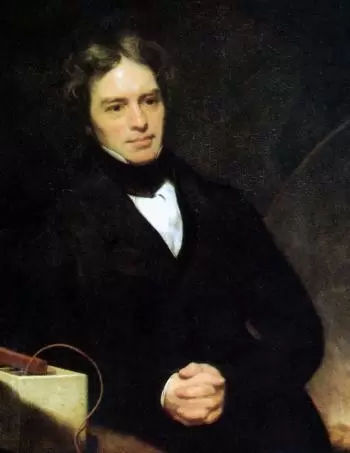
Michael Faraday was an important English chemist and physicist. He was born on September 22, 1791 in Newington and died on August 25, 1867 in London.
He discovered electromagnetic induction, that the magnetic field rotates the plane of polarization of light. He determined the basic principles of electrolysis, was the first to liquefy chlorine gas, and invented the electric motor.
The unit of electrical capacity in the international system is farads (F) in honor of Michael Faraday.
Faraday's biography
Michael Faraday was born into a humble family on September 22, 1791 in Newington Butts, now part of the London Borough of Southwark, but then a suburb of Surrey. Faraday was only able to get the most basic school education for financial reasons.
He was an apprentice bookbinder at the age of fourteen. He began to expand his knowledge by reading the books he worked with.
Faraday married Sarah Barnard (1800-1879) on June 12, 1821.
These are some of the merits obtained throughout his life:
-
The University of Oxford awarded Faraday an honorary Doctor of Civil Law (1832).
-
Member of the Royal Society in 1824. Twice he rejected the presidency.
-
First professor of chemistry at the Royal Institution (1833).
-
Honorary Foreign Member of the American Academy of Arts and Sciences (1832).
-
Foreign member of the Royal Swedish Academy of Sciences in 1838.
-
He was one of eight foreign members elected to the French Academy of Sciences (1844).
-
Associate member of the Royal Netherlands Institute (1849) and later became a foreign member.
What were the contributions of Michel Faraday?
Faraday made numerous contributions during the early nineteenth century in different fields of science. Here are the most important ones:
Contributions in chemistry
Faraday did his first chemical job as an assistant to Sir Humphry Davy with whom he got to work after attending Davy's lectures.
His contributions to chemistry include the following:
-
Liquefying of gases such as chlorine.
-
Investigated steel alloys
-
He produced several new types of glass for optical purposes with which he carried out work related to the polarization of light and magnetism.
-
Invention of an early form of the Bunsen burner.
-
Faraday discovered benzene and other chemicals.
-
Determination of the composition of the clathrate hydrate of chlorine discovered by Sir Humphry Davy in 1810.
-
Discovery of the laws of electrolysis
-
He popularized terminology like anode, cathode, electrode, and ion, and terms largely proposed by William Whewell.
-
He reported on what were later called metallic nanoparticles.
-
Discovery that the optical properties of gold colloids differ from those of the corresponding bulk metal (1847). This was possibly the first reported observation of the effects of quantum size and can be considered the birth of nanoscience.
Contributions in the electromagnetic field
Faraday worked in the field of physics in which the electric and magnetic field are related. One of his purposes was to find a way to generate electricity through magnetism.
-
Creator of Faraday's law: one of the fundamental laws of electromagnetism and that James Clerk Maxwell included among the so-called four Maxwell equations.
-
Father of the electric motor and electric generators: Michael Faraday developed a system in which he wound an electric cable around a magnet. If an electric current was circulated through this conductor, mechanical energy could be obtained. Later, he discovered that the effect was reversible and that electricity could be obtained from mechanical work (generators).
-
Discovery of diamagnetism (1845), which is a phenomenon by which many materials have a weak repulsion when exposed to a magnetic field.
-
Discoverer of the Faraday effect.
-
Invention of the Faraday cage which is an experiment that showed that charge exists only outside of a charged conductor.
-
He developed a new general theory of electricity (1839): electricity causes stresses in matter. In this sense, electrical conductors are the materials in which these stresses can be quickly eliminated and a voltage is generated sequentially and periodically.